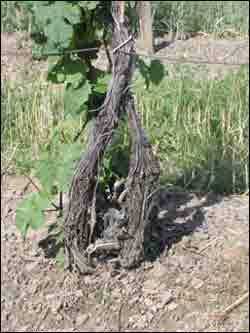Plant wounds trigger bacteria

Tom Burr - Crown gall disease on the lower trunk of a grapevine in the Finger Lakes region.
How does a wound in certain plants like roses and grapevines develop into a tumor? The answer appears to lie in a common soil bacterium that is able to “smell” the wound and speed up the infection process.
Cornell University microbiologist Steve Winans says that the pathogen Agrobacterium tumefaciens enters the wound where it copies the genes required for infection, which can slip into the plant’s cells and their nuclear DNA, causing a cancer-like disease called crown gall. The cells of the crown gall tumor synthesize compounds called opines, which serve as food for the bacterial invaders.
The discovery may lead to a cure for crown gall disease, which takes a large economic toll on fruit and wine-grape crops each year.
“Mutant forms of Agrobacterium are also widely used in agricultural biotechnology for their ability to create transgenic plants containing new genes of scientific or economic interest,” said Winans, a professor in Cornell’s Department of Microbiology. “Perhaps these findings could be exploited to get more effective delivery of DNA for biotechnology uses.”
He is the senior author of a paper published in a recent issue of the Proceedings of the National Academies of Science (PNAS, Vol. 102, No. 41).
“Many other disease-causing bacteria are like Agrobacterium, in that they can detect specific chemical signal molecules that are released from plants or animals, and respond by initiating an attack on these host organisms,” Winans said. “For example, others have shown that the bacteria that cause cholera express protein toxins only when they detect bile salts in the host’s intestine. It will be interesting to see whether those bacteria also increase the replication of the genes necessary for disease.”
The bacterium employs a large tumor-inducing plasmid to do its dirty deed. The plasmid is a ring of DNA that is separate from the chromosome and is not essential for the bacterium’s survival but is required for tumor growth. The plasmid can also transmit itself from one bacterial cell to another when the two cells touch one another, in bacterial congress.
The plasmid recognizes organic compounds called phenols that leak out of damaged cells when a plant is wounded. A bacterial protein called VirA acts like an antenna, detecting phenols in a plant wound; the phenols, in turn, signal VirA to add a phosphate (PO4) group to a related protein, VirG, converting it into an active form.
The new study shows that the activated form of VirG causes the tumor-inducing plasmid to replicate up to five times faster than normal by increasing the expression of a protein called RepC, which is required for replication of the plasmid. The extra copies of this DNA enhance the ability of the bacterium to cause tumors, which grow when a fragment of the plasmid DNA invades the plant’s own DNA.
Crown gall tumors mostly strike the trunks or stems of dicot plants, trees or vines near the ground where freezing occurs during winter and a wound forms in spring. Such fruit trees as cherries and peaches, raspberries and high-quality vine grapes like chardonnay and cabernet sauvignon tend to be susceptible to the disease, which can stunt or kill a plant. Grafting can also lead to infections.
“There are really no chemicals, no sprays that can control this disease,” said Tom Burr, a plant pathology professor at Cornell and an expert on crown gall disease. “This is really the cutting-edge research on the biology of the pathogen, so now we can think about how to develop novel controls for gall tumors.”
The study was funded by Monsanto and the National Institutes of Health.
Media Contact
More Information:
http://www.cornell.eduAll latest news from the category: Agricultural and Forestry Science
Newest articles

Superradiant atoms could push the boundaries of how precisely time can be measured
Superradiant atoms can help us measure time more precisely than ever. In a new study, researchers from the University of Copenhagen present a new method for measuring the time interval,…

Ion thermoelectric conversion devices for near room temperature
The electrode sheet of the thermoelectric device consists of ionic hydrogel, which is sandwiched between the electrodes to form, and the Prussian blue on the electrode undergoes a redox reaction…

Zap Energy achieves 37-million-degree temperatures in a compact device
New publication reports record electron temperatures for a small-scale, sheared-flow-stabilized Z-pinch fusion device. In the nine decades since humans first produced fusion reactions, only a few fusion technologies have demonstrated…





















